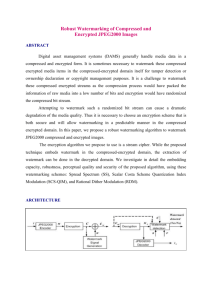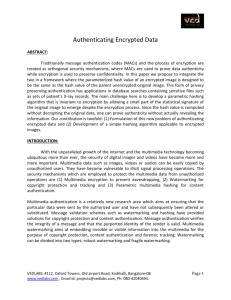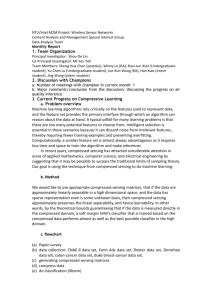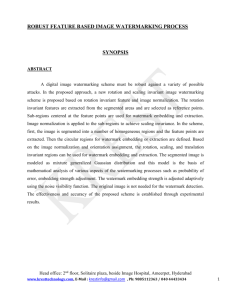Abstract - ChennaiSunday
advertisement
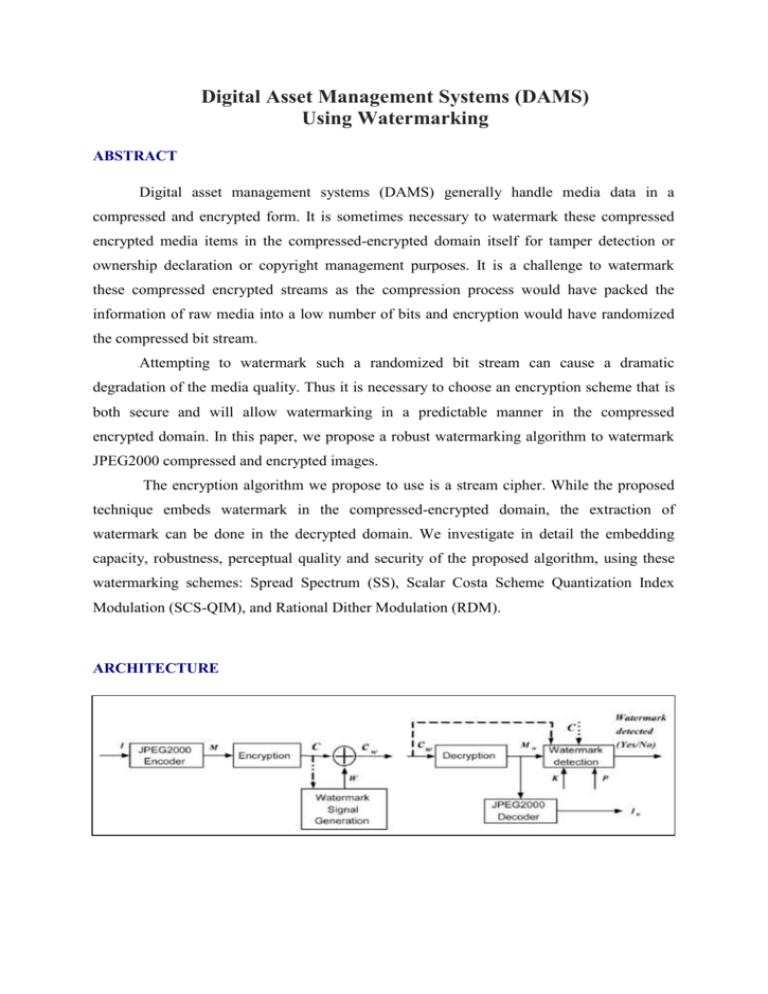
Digital Asset Management Systems (DAMS) Using Watermarking ABSTRACT Digital asset management systems (DAMS) generally handle media data in a compressed and encrypted form. It is sometimes necessary to watermark these compressed encrypted media items in the compressed-encrypted domain itself for tamper detection or ownership declaration or copyright management purposes. It is a challenge to watermark these compressed encrypted streams as the compression process would have packed the information of raw media into a low number of bits and encryption would have randomized the compressed bit stream. Attempting to watermark such a randomized bit stream can cause a dramatic degradation of the media quality. Thus it is necessary to choose an encryption scheme that is both secure and will allow watermarking in a predictable manner in the compressed encrypted domain. In this paper, we propose a robust watermarking algorithm to watermark JPEG2000 compressed and encrypted images. The encryption algorithm we propose to use is a stream cipher. While the proposed technique embeds watermark in the compressed-encrypted domain, the extraction of watermark can be done in the decrypted domain. We investigate in detail the embedding capacity, robustness, perceptual quality and security of the proposed algorithm, using these watermarking schemes: Spread Spectrum (SS), Scalar Costa Scheme Quantization Index Modulation (SCS-QIM), and Rational Dither Modulation (RDM). ARCHITECTURE EXISTING SYSTEM One of the weaknesses of all encryption systems is that the form of the output data (the cipher text), if intercepted, alerts the intruder to the fact that the information being transmitted may have some importance and that it is therefore worth attacking and attempting to decrypt it. This aspect of cipher text transmission can be used to propagate disinformation, achieved by encrypting information that is specifically designed to be intercepted and decrypted. In this case, system assume that the intercept will be attacked, decrypted and the information retrieved. The ‘key’ to this approach is to make sure that the cipher text is relatively strong and that the information extracted is of good quality in terms of providing the attacker with ‘intelligence’ that is perceived to be valuable and compatible with their expectations, i.e. information that reflects the concerns/ interests of the individual and/or organization that Encrypted the data. This approach provides the interceptor with a ‘honey pot’ designed to maximize their confidence especially when they have had to put a significant amount of Work in to ‘extracting it’. The trick is to make sure that this process is not too hard or too easy. ‘Too hard’ will defeat the object of the exercise as the attacker might give up; ‘too easy’, and the attacker will suspect a set-up. Limitations of existing system This system allows limited participation to avoid traffic flow and from attack. It provides more security. It is applicable for authentication of e-documents. It is most important for securing certificates, personnel documents, bond-papers that are send via email. PROPOSED SYSTEM This system presents a method of ‘hiding’ encrypted information in a color digital image. In principle, any cipher can be used to do this providing it consists of floating point (or decimal integer) numbers that are ideally, uniformly distributed. The scheme allows for the authentication and self-authentication of documents such as letters, certificates and other image based data. We investigate in detail the embedding capacity, Robustness, perceptual quality and security of the proposed algorithm, using these watermarking schemes: Spread Spectrum (SS), Scalar Costa Scheme Quantization Index Modulation (SCS-QIM), and Rational Dither Modulation (RDM). MODULES 1. Watermarking Domains a. Compressed Domain Watermarking b. Encrypted Domain Watermarking c. Watermarking Retrieval 2. Five Stages of JPEG2000 Compression 3. Watermarking Schemes to Compressed Encrypted Stream 4. Data Embedding MODULES DESCRIPTION 1. Watermarking Domains A) Compressed Domain Watermarking In this module, a small modification in the compressed data may lead to a considerable deterioration in the quality of decoded image. Thus the position for watermark embedding has to be carefully identified in the compressed data, so that the degradation in the perceptual quality of image is minimal. B) Encrypted Domain Watermarking and Watermarking Retrieval In this module, in an encrypted piece of content, changing even a single bit may lead to a random decryption. Therefore the encryption should be such that the distortion due to embedding can be controlled to maintain the image quality. It should also be possible to detect the watermark correctly even after the content is decrypted. Also, the compression gain should not be lost as encryption may lead to cipher text expansion. 2. Five Stages of JPEG2000 Compression 1. In the first stage the input image is preprocessed by dividing it into non-overlapping rectangular tiles, the unsigned samples are then reduced by a constant to make it symmetric around zero and finally a multi-component transform is performed. 2. In the second stage, the discrete wavelet transform (DWT) is applied followed by quantization. 3. In the third stage multiple levels of DWT give a multi-resolution image. The lowest resolution contains the low-pass image while the higher resolutions contain the highpass image. These resolutions are further divided into smaller blocks known as codeblocks where each code-block is encoded independently. 4. In the Fourth Stage, the quantized- DWT coefficients are divided into different bit planes and coded through multiple passes at embedded block coding with optimized truncation (EBCOT) to give compressed byte stream in the fourth stage. 5. In the Fifth Stage, the compressed byte stream is arranged into different wavelet packets based on resolution, precincts, components and layers in the fifth and final stage. 3. Watermarking Schemes to Compressed Encrypted Stream 1. Spread Spectrum (SS) 2. Scalar Costa Scheme (SCS-QIM) and 3. Rational Dither Modulation (RDM) for the purpose and study the bit error rate of detection and the quality versus payload capacity trade-off. The schemes can be performed either in encrypted or decrypted compressed domain to retrieve or destroy the watermark. The attacks are considered in compressed domain since watermark detection for ownership verification, traitor tracing, or copyright violation detection can easily be done as the content is often copied and distributed in compressed format 4. Data Embedding In this module, the average payload capacity versus number of bit planes watermarked under different resolutions using SCS-QIM Average payload capacity is given here as the ratio of the average embedded number of bits to the average compressed stream size (in bytes), where average is computed as a simple mean. The increase in payload capacity is due to increase in size of dimensions of higher resolutions, generating more number of compressed bytes, which provides more space for embedding. SYSTEM REQUIREMENT SPECIFICATION HARDWARE REQUIREMENTS System : Pentium IV 2.4 GHz. Hard Disk : 80 GB. Monitor : 15 VGA Color. Mouse : Logitech. Ram : 512 MB. SOFTWARE REQUIREMENTS Operating system : Windows 7 Ultimate Front End : Visual Studio 2010 Coding Language : C#.NET Database : SQL Server 2008
